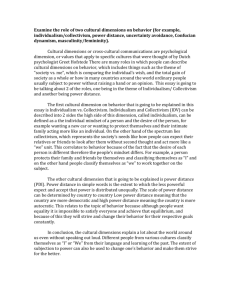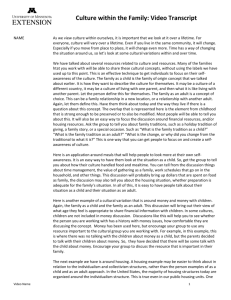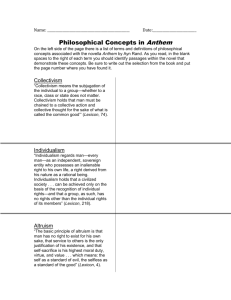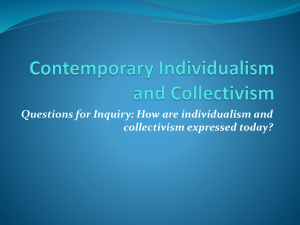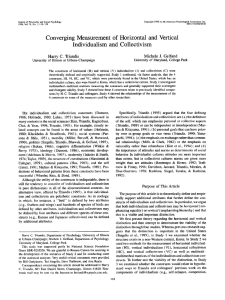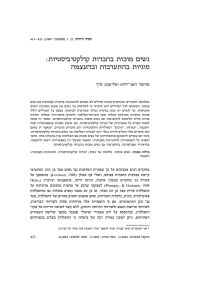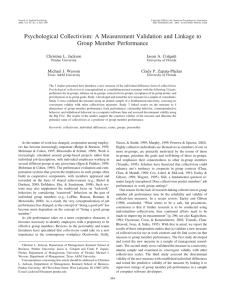Individualism and collectivism: Do they predict coping and
advertisement
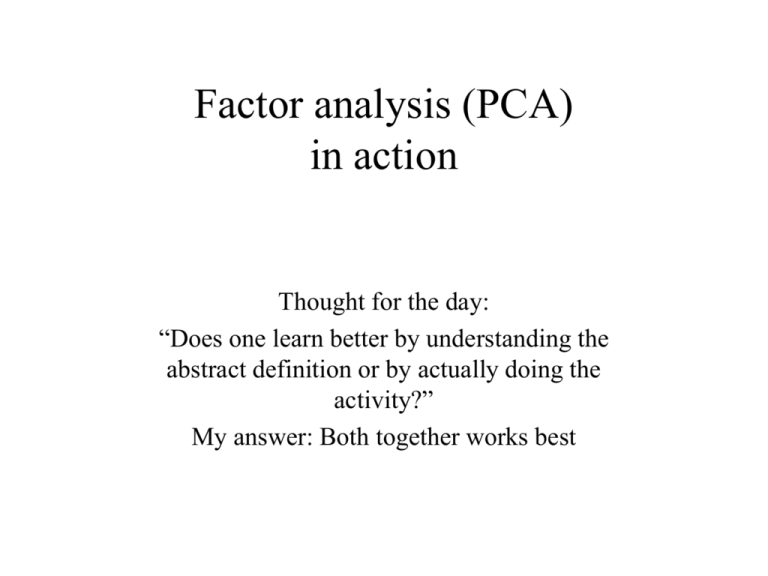
Factor analysis (PCA) in action Thought for the day: “Does one learn better by understanding the abstract definition or by actually doing the activity?” My answer: Both together works best Demonstration of the process • I’d like to show you how to do an EFA on a dataset. • Further, I’d like to show you how messy it can be. A bit like finger painting. • This dataset has to do with individualism and collectivism. I and C • Harry Triandis’s book, Individualism and collectivism (1995), is a classic in that it defines I and C and summarizes several decades of research concerning these constructs. • He says that a “subjective culture” becomes organized around a central theme and this is the basis for I and C. It’s a way of thinking about the self in relation to others. Definition of Collectivism • Collectivism is: 1) emphasis on the views, needs, and goals of the ingroup rather than the self; 2) emphasis on behaviour determined by social norms and duties rather than by pleasure or personal advantage; 3) common beliefs that are shared by the ingroup; and 4) willingness to cooperate with the ingroup. Definition of Individualism • Individualism is a social pattern that consists of: 1) loosely linked individuals who view themselves as independent of collectives; 2) are primarily motivated by their own preferences, needs, rights, and contracts; 3) give priority to their personal goals over the goals of others; and 4) emphasize rational analyses of the advantages and disadvantages of associating with others. A huge amount of research • I and C were initially laid down by Hofstede in his cross-cultural study of business people around the world in 1980. • Still, the I/C distinction has proven useful in crosscultural research. • Psychometrically, what do we know? – Few good measures exist. – There is an assumption now that I and C are orthogonal. – Triandis wanted to combine I and C with another dimension (see the next page). Vertical vs. horizontal • Triandis conceptualized I and C as crossed with V and H. He borrowed the categorization from Markus and Kitayama (1991). • M & K described a two-by-two categorical system of the self: – Independent vs. interdependent; and – Same vs. different. • In the same way, Triandis thinks of V & I this way: – In collectivist societies, horizontal refers to a sense of social cohesion; and vertical refers to serving the ingroup. – In individualist societies, horizontal refers to treating others as individuals; and vertical refers to competition being healthy. • In short, verticality refers to inequality and the importance of rank; and horizontality refers to basic equality. Triandis’s taxonomy verticality I sacrifice my self-interest for the sake of the group. Winning is everything. individualism collectivism I prefer to be direct and forthright with people. Group harmony is important. horizontality Key things to notice • First point: no item is pure I, C, V, or H. All items are combinations of either I/C and V/H. Not the usual way to do it. • It looks as though I and C are opposites, i.e., not orthogonal. Is that true? • Is looks as though V and H are opposites too. Is that true? • Will we find in an EFA the pattern described above? Good question. • Note that I’m actually doing something “wrong” here, i.e., doing an EFA on a previously identified factor structure. I should do a CFA (later). Let’s try the first run • It identifies 9 eigenvalues greater than 1.0. And that is completely useless. Notice that it did not converge—bad sign. • An examination of the scree plot suggests either 3 or 4 factors. • Let’s begin with 4 factors. 4-factor solution • Notice that it actually converged (in 10 iterations-which is so-so). Accounts for 38% of the variance. • A scan of the obtained factor loadings shows the following: – – – – 1st factor: 7 HC; 2 HI; 1 VC 2nd factor: 7 VI 3rd factor: 5 VC; 1 HC 1 HI (rev) 4th factor: 4 HI; 1 HC • Some order here, but it’s still sort of messy. 3-factor solution • Accounted for 33% and converged in 12 iterations. Percent variance is a bit low. • Let’s look at the factors: – 1st factor: 6 HC; 6 VC – 2nd factor: 8 VI – 3rd factor: 5 HI • Seems like we have a single collectivism factor whereas the two individualisms are distinguished from each other. Not a bad result for a Western sample. 2-factor solution • Accounts for 24.5% of the variance and converged in 3 iterations. – 1st factor: 7 HC; 5 HI; 1 VC – 2nd factor: 8 VI; 3 VC • Umm, what does this mean? Seems like we have a horizontal factor and a vertical factor. It doesn’t split by I and C. Okay, so what’s the best solution? Remember that I check the Cronbach’s alphas and correlations. • 4-factor solution: as = .75; .79; .66; .49 • 3-factor solution: as = .73; .79; .70 • 2-factor solution: as = .78; .78 • 1-factor solution: a = .75 So which is best? I like the 3-factor solution. Let’s check the correlations. Are there any high correlations? Factor 1 Factor 2 Factor 2 .15* Factor 3 .12 .03 • So, the 3-factor solution looks pretty good. • 2-factor: r = .06. Nothing is perfect • Several things to notice: – The FA programme does not tell you what the optimal factor solution is, one has to discern it from the various signs. – Involves a number of FA runs. Then you follow up with Cronbach’s alphas and correlations. – The final solution is debatable. Other researchers might choose different factor structures.
